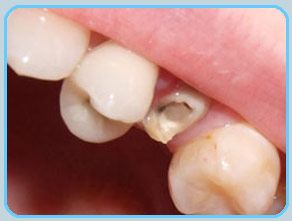
Crowns at Torgersen Dental - Camarillo & Simi Valley
A dental crownis described as a tooth-shaped "cap" that is placed over a tooth - protecting the tooth - to build up its shape and size, strength and / or to improve its condition. These crowns, when cemented into position, completely encase the entire visible part of the tooth that lies on top of the gum line.
There are several factors that may contribute to erosion, cracking and breaking of one's tooth (for instance, age, fillings or perhaps tooth decay). In cosmetic dental care, capped teeth or crowns are used to fix most of these issues.
 In the event that the structure of the complete tooth is severely sacrificed, a crown, which covers all surfaces of the tooth, should be placed. The example to the right represents a broken tooth.
In the event that the structure of the complete tooth is severely sacrificed, a crown, which covers all surfaces of the tooth, should be placed. The example to the right represents a broken tooth.
The initial step would be to prepare the tooth for a crown that requires us to reduce the actual tooth so the lab has enough space to make a life-like crown. At the first visit, we take an impression, select the proper color for the crown, and make a temporary crown.
Your impression is then sent to the local lab to make the crown, which is then tested and adjusted if necessary. Our job is to communicate to the laboratory technicians what your preferences and needs are, so your new crown will be in harmony with the neighboring teeth.
Before your new crown is cemented, we check the contacts, the fit, the bite, and the color to make sure you have the same typical features of your natural teeth.
Importance of Dental Crown
The following situations show the uses and importance of a dental crown:
- It protects a vulnerable tooth (for example, from decay) from breaking or to hold the pieces together of a broken tooth.
- It restores an already broken tooth or a tooth that has been severely worn down.
- It covers and supports a tooth with a large filling when there is not a lot of tooth left.
- It can anchor a partial denture in place.
- It covers deformed or severely discolored teeth.
- It covers a dental implant to replace a missing tooth.
Available Types of Crowns
Permanent crowns can be made from all metal, porcelain-fused-to-metal, all resin, or all ceramic.
- Metals used in crowns are gold alloy, other alloys (such as, palladium), or a base metal alloy (such as nickel or chromium). Unlike other types of crowns, less tooth structure needs to be removed with metal crowns and tooth wear against the other teeth can be minimized. Metal crowns withstand biting and chewing forces well and possibly last the longest in terms of wear. In addition, the metal crowns hardly chip or break. Metallic color is the biggest drawback. Metal crowns tend to be an ideal choice for out-of-sight molars.
- Porcelain-fused-to-metal dental crowns, can be color matched to your adjacent teeth (unlike the metallic crowns). However, more wearing to the opposing teeth occurs with this type of crown compared with metal or resin crowns. The porcelain part of the crown can also chip or break off. Besides the all-ceramic crown, porcelain-fused-to-metal crowns look most like normal teeth. However, sometimes the metal underlying the crown's porcelain can show through a dark line, especially at the gum line and even more so if your gum diminish. These crowns can be an ideal choice for front or back teeth.
- All-ceramic or all-porcelain dental crowns produce the most natural color match of any type of crown and may be more appropriate for people with metal allergies. However, they are not as strong as porcelain-fused-to-metal crowns and they wear down the opposite teeth a little more than metal or resin crowns. All-ceramic crowns are an ideal choice for front teeth.
- Temporary and permanent : Temporary crowns can be made in Dr. Trent and Gina Torgersen's office whereas permanent crowns are made in a dental laboratory. Temporary crowns are made of acrylic or stainless steel and can be used as temporary tooth coverage until the permanent crown is fabricated.
Steps Involved in Preparing a Tooth for a Crown
Preparing a tooth for a crown usually requires two visits to Dr. Trent and Gina Torgersen –– the first step involves examination, and preparation of the tooth, the second visit involves placement of the permanent crown.
First Visit: Examining and preparing the tooth.
During the first visit in preparation for a crown, Dr. Trent and Gina Torgersen may take a couple of X-rays to inspect the roots of the tooth receiving the crown and surrounding bone. If the tooth has deep decay resulting in a possibility of infection or injury to the tooth's pulp, root canal therapy may first be required.
Before starting the process of making your crown, Dr. Trent and Gina Torgersen will anesthetize (numb) your tooth and the gum tissue that surround the tooth. Then, the tooth receiving the crown is filed down along the chewing surface and sides to give space for the crown. The amount to be removed depends on the type of crown used (for example, all-metal crowns are thinner, requiring less tooth structure removal compared to all-porcelain or porcelain-fused-to-metal ones). If, on the other hand, a large area of the tooth is missing (due to decay or damage), Dr. Trent and Gina Torgersen will use filling material to "build up" the tooth to be a foundation for the crown.
After reshaping the tooth, Dr. Trent and Gina Torgersen will use impression putty to make an impression of the tooth to receive the crown. Impressions of the teeth above and below the receiving tooth of the dental crown will also be made to make sure that the crown will not affect your bite.
The impressions are then sent to our local dental lab where the crown will be made. The crown is usually sent back to Dr. Trent and Gina Torgersen's office in 2- 3 weeks time. If the crown is made of porcelain, Dr. Trent and Gina Torgersen will also choose the shade that most closely matches the color of the neighboring teeth. During this first office visit, Dr. Trent and Gina Torgersen will make a temporary crown to cover and protect the prepared tooth while the permanent crown is being made. Temporary crowns are usually made of acrylic or stainless steel and are held in place with the use of temporary cement.
Second Visit: Receiving the permanent dental crown.
At your second visit, Dr. Trent and Gina Torgersen will take out your temporary crown and check the fit and color of the permanent crown. If everything is satisfactory, a local anesthetic will be used to numb the tooth and the new crown will be permanently cemented in place.
 Before and After Crown Treatment
Before and After Crown TreatmentTaking Care of Your Temporary Dental Crown
Because temporary dental crowns are for short-term use, we suggest that a few precautions be taken with your temporary crown until a permanent crown is ready. These include:
- Avoiding sticky, chewy foods (such as, chewing gum, caramel), which have the capability of grabbing and pulling off the crown.
- Minimizing the use of the side of your mouth with the temporary crown. Shift the bigger part of your chewing to the other side of your mouth.
- Avoiding of chewing hard foods (such as raw vegetables), which could dislocate or break the crown.
- Sliding of flossing material out-rather than lifting out-when cleaning your teeth. Lifting the floss out, as you usually do, might pull off the temporary crown.
Life Span of Dental Crowns
Dental crowns last between 5 and 15 years, on average. The life span of a crown depends on the amount of crown’s exposure to "wear and tear", good oral hygiene practices, and personal mouth-related habits (grinding or clenching your teeth, chewing ice, biting your fingernails, and using your teeth to open packaging should be avoided).
Call for your appointment today!


